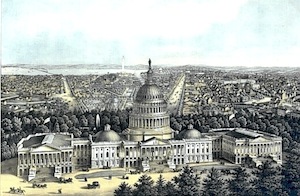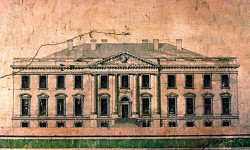What did the Residence Act of 1790 accomplish?
 July 16, 1790 — At last, the question of the location of the nation’s capital was settled today when the The Residence Act of 1790 was passed. The Federal government had been located in New York City, but that decision was fiercely debated for 7 years.
July 16, 1790 — At last, the question of the location of the nation’s capital was settled today when the The Residence Act of 1790 was passed. The Federal government had been located in New York City, but that decision was fiercely debated for 7 years.
Philadelphia was in the running, and was the capital for 10 years, from 1790-1800. George Washington and John Adams lived in a mansion at 6th & Market Streets, which served as the presidential home.
But it was Thomas Jefferson, James Madison, and Alexander Hamilton who came up with a compromise. On their recommendation, Congress decided the permanent capital would be the as-yet-unbuilt District of Columbia. The decision, historians explain, was partially to placate southern states for accepting Alexander Hamilton’s financial plan for federal assumption of northern states’ debt.
Who decided how the new city would look?  President George Washington commissioned French engineer Pierre-Charles L’Enfant to create a plan for the city. Washington liked L’Enfant’s designs, which included wide avenues and open spaces; as GW didn’t want the capital to become a city of crowded buildings. He knew that people would need parks where they could walk and relax. So, the streets of the capital were oriented in a north, south, east, and west grid pattern.
President George Washington commissioned French engineer Pierre-Charles L’Enfant to create a plan for the city. Washington liked L’Enfant’s designs, which included wide avenues and open spaces; as GW didn’t want the capital to become a city of crowded buildings. He knew that people would need parks where they could walk and relax. So, the streets of the capital were oriented in a north, south, east, and west grid pattern.
Thanks to L’Enfant’s careful planning, when you stand on the steps of the U.S. Capitol today, you can look down the mall all the way to the Washington Monument and the Lincoln Memorial.
Sources
Words of Wisdom
No nation, perhaps, had ever before the opportunity offered them of deliberately deciding on the spot where their capital city should be fixed.… And, although the means now within the power of the country are not such as to pursue the design to any great extent, it will be obvious that the plan should be drawn on such a scale as to leave room for that aggrandizement and embellishment which the increase of the wealth of the nation will permit it to pursue at any period, however remote. Viewing the matter in this light, I am fully sensible of the extent of the undertaking.





